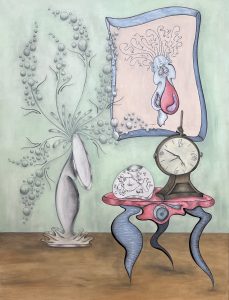A Formula to Sanity and Personal Power
Stop punishing yourself for wanting things.
You want a new phone. You want a big house. You want a new partner. And you tell yourself you deserve these things, but that you don’t need these things.
So, you feel like a selfish, materialistic asshat.
Need-Want Confusion is why you feel like crap.
What if I told you that what you want is what you need — and ignoring wantsis the reason you are miserable? I’d be contradicting every don’t be selfish principle on the planet.
Good. ’Cause I’m sick of that bullshit, too.
So, you can stay and chat or swipe past this article so you can read some not-quite-porn or dating crap. Or some sappy soup-for-the-soul story. Or bitcoin or social media strategies. Or career advice. Go ahead. Waste another day of your life putting a bandaid over a hemorrhage. Because this series of articles is going to get nasty, ask you to dig deep, and be unapologetic. There’s your trigger warning, snowflake.
Still here? Okay, then.
Make a list of everything you want. Don’t self-edit. Write it all down. Your list may include: More followers. More likes on your posts. That newest phone. That perfect partner. Those fake eyelashes. Conquering your anxiety. That sports car. Cookies. Learning to dance. A flatter stomach. More money. The pumps with the pink straps. That fishing rod. An orgasm. A distinguished career or finding your calling. That beach vacation. The entertainment subscription.
Now, evaluate your list. Did you list wants or needs? Sure, you understand the difference. But you will — like others — label items like more money, as a want. You might say: I need food, clothing, sleep, water, air. That’s all I need to survive. I don’t need the newest phone or an orgasm. In fact, an individual’s list of wants points to precisely what that individual needs. After coaching hundreds of people, I find many of us make this mistake.
Because, for some ungodly reason, no one teaches the concept of need as it relates to motivation and happiness. So you run that hamster wheel of doom, spinning endlessly to nowhere. As humans, we are ignorant of the manner in which wants and needs play out to define our lives. In that ignorance, most of us do not live with purpose to satisfy those needs. So we spend our lives pursuing the wrong wants.
The Universal Human Needs
Why do people do what they do? Pursue what they do?
Positive psychologists, especially Martin Seligman, arrived at a list of universal human needs. These are the things every human being needs to be motivated and happy — no matter the age, gender, socio-economic status, education, religion, culture.
You may be familiar with this concept: most college courses mistakenly focus on Abraham Maslow’s Hierarchy of Needs. I say mistakenly because Maslow’s design was based on a picture of individual temperament — and incorrectly suggested that needs were successive. In Maslow’s theory, every person seeks self-actualization as a life goal. He also suggested that one could not pursue love and belonging without securing safety needs. In later life, Maslow admitted the needs were not successive but cohesive.
We can pursue all needs at the same time. And not everyone seeks self-actualization as the ultimate need.
So where does that leave us? Aside from you wondering why your psych professor did not update her lectures, you may wonder what the needs are — and why knowledge of them matters.
Because you can learn a lot about yourself by tracing your wants to your innate needs. And, you can live a happy, satisfying life by being cognizant of how needs and wants relate — and focusing on what you need. Not what Doris, the neighbor, needs. Not what your pastor or best friend tell you what you need. Learning what you need. And learning how to fulfill those needs.
In my research, I found several valid human need theories, each more complex than the last. By distilling them and performing several qualitative studies, I arrived at what I call the Needs Alignment Model (NAM). It’s easy to master, recall, and apply. No certificate or degree required.
In this article, I present that model so you can master the basics. We will discuss how the needs are satisfied or not — and how to maintain balance or recognize imbalance in the second article. In the third article, we will discuss how to findand use your needs formula. And in the last article of the four, I will help you decipher why you are so unhappy, dissatisfied, frustrated, and depressed. Consider it 20 minutes of your attention for a lifetime of joy.
ONE: STABILITY
You lose your job. You have a health crisis. You can’t afford your car payment. Someone breaks into your house. Your partner is disloyal.
The fear you experience during these life trials undermines your need for stability. You want to trust your world will keep you safe. Maslow used this need as the basis of his pyramid, but we know people living in a war zone or in the street can still be happy. And we know the c-level exec in her McMansion can still be unhappy. Stability is only one need — necessary but only part of the complexity of the human condition.
TWO: STIMULATION
The partner to your need for stability is your need for stimulation. Imagine having a secure job but being bored. Having a marriage without passion. Or eating the same thing and sitting in the same spot watching the same shows day after day.
Humans need to have fun, to take risk, the act and move, and to feel. This is why you want that new phone. Or the next job. You want to feel something and change is a straightforward route to satisfying your need for stimulation.
THREE: IDENTITY
Your self identity is the third need. We can call it ego, but the identity need is more involved. Each of us wants to be seen as unique. Your very name satisfies this need.
You get an award. Or a promotion or title. Someone notices your sense of style and compliments your home’s decor. They want your cookie recipe. Or that friend calls you because you are the only one who can help.
You feel special. You stand out.
FOUR: CONNECTION
The partner to the identity need is our need for connection. We want to belong, be part of a group, be a member of a family. And we want to be recognized as part of that tribe. That’s the key.
Our need for connection is satisfied when we disappear as one of that collective. Unlike the identity need to stand out, our need for connection is the need for equality and parity.
FIVE: EXPRESSION
All humans need to contribute in a meaningful way. We want to express who we are, what we think, and how we see the world.
You can appreciate how our need for expression is intimately connected with our need for identity. Expression is when our personal truth, the authentic self, is communicated. Whether you are lecturing, dancing, or helping a friend, your need for expression is satisfied.
SIX: AWARENESS
Expression is the active partner to the receptive need for awareness. We each need experiences, opportunities to learn and grow.
When you take a class or read a book, travel and meet new people, have a conversation with another whose lifestyle or culture is dissimilar to yours, your awareness need is satisfied.
SEVEN: MEANING
In the examination of needs, the seventh, the need for meaning, stands alone. Some people subscribe to a religion or a philosophy. Others reject the idea of a higher power, but seek meaning and purpose in their service to others.
The constant is the need to find a something bigger than self. A reason for existence. A why to this big life mystery. And while it has no obvious partner in the need list, it has a vital connection to each.
SUMMARY
These seven needs are universal. Everyone — no matter his or her demographic traits — has these needs and seeks to fulfill them. The key is understanding which needs you value for you. Because although we each have these needs, we each have the drive to satisfy them in different proportions. And that formula is the subject of my next article in this series.
Stick with it. I promise you, the return on your investment will be well worth it.
And I will leave you with a few questions:
Which need(s) is/are satisfied by owning the nicest house on the block?
Which need(s) is/are satisfied by interacting on social media?
Which need(s) is/are satisfied by reading and applying this material?



